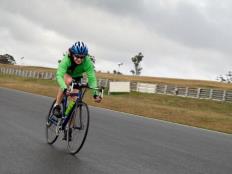If you choose to do the 20-minute test, take the average HR and power output for the entire 20 minutes. The HR will become your LTHR. For power, you'll take 95 percent of the power number. This will become your TP.
For the 8-minute test, you'll take the average HR and power from both efforts, average them together, and use the HR for to get your LTHR and calculate 92 percent of that power number to obtain your TP. You don't have to do all three tests, but sometimes it is a good idea to do more than one to make sure your numbers are in the same ballpark.
Once you have those numbers (Lactic Threshold Heart Rate and Threshold Power) you can use the following chart to create your training zones:

More: Best Buy: Power Meter or Heart Rate Monitor?
Step 3: Progressive Build to Overload
Depending on what phase of training you're in, use these training zones to develop a plan to meet your goals. As you begin training with power, you must know what level of fitness you're at in order to gauge where you want to go.
For example, if you are entering a race season and you're at a point where you want to improve your power at Lactic Threshold, your target workouts should involve a lot of time in zone 4.
More: 5 Reasons to Train with a Power Meter
In the beginning of this block, start with easier workouts, and each week increase the intensity. The intensity can be built by doing one or more of the following:
- Increase riding time of intervals
- Increase power output of each interval within the given zone
- Increase the number of intervals within a workout
By increasing the intensity each week, you create an overload, which triggers your body to adapt. As you move to the next block, start at a higher level than you started the previous block but slightly lower from where you ended the last block of training.
Step 4: Recovery
The most overlooked period of training is often the recovery period. The recovery period is also the most important part of any good training plan. It's not the work that makes you stronger—it's the recovery.
More: 5 Ways to Increase Power on the Bike
The recovery period is where your body gets the time to rebuild from the strenuous work you've put it through. The key to recovery is planning your rest period at the right time. Many training plans consist of a three-week on, one-week off plan. During the off week, the athlete does very little training, and what training is being done during this period is focused primarily in the active recovery zone.
At the end of a four-week cycle, start over. Before you begin a new block of training, conduct another field test on the same road or as close to the same conditions as possible. Use this data to tweak your numbers and obtain new training zones based on your improvements.
By doing these monthly field tests, you'll ensure that you are training to the correct zones and measuring your progress correctly.
More: 9 Post-Ride Recovery Rituals
 Ready to ride? Search for a cycling event
Ready to ride? Search for a cycling event- 2
- of
- 2








Discuss This Article